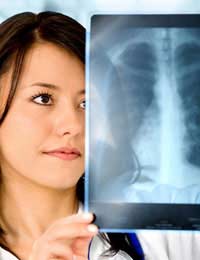Osteoporosis and Back Pain

Osteoporosis is a disorder associated with reduction in bone mass, where the bones become weaker and more brittle. This leads to an increase in the risk of fracture. Osteoporosis is more common in post-menopausal women, but can also occur in elderly men, and in people who have a poor diet or who have suffered from eating disorders. Osteoporosis can lead to spinal fractures, which causes back pain.
Causes of Osteoporosis
Bone loss occurs naturally as people age, but certain factors increase the rate of bone loss, leading to osteoporosis. These factors include inadequate diets, especially those low in calcium and vitamin D, lack of access to sunlight (so having insufficient levels of vitamin D), alcohol abuse, smoking, lack of weight-bearing exercise, low levels of sex hormones (especially in post-menopausal women, or people who are seriously underweight), the use of therapeutic drugs (such as immunosuppressants and steroids) and certain diseases, such as endocrine disorders, rheumatoid arthritis and diabetes.Back Pain and Osteoporosis
Osteoporosis affects all bones in the body, including the vertebrae (the bones of the spine). In its early stages, osteoporosis has no symptoms, and people may have a number of small hairline fractures without being aware of them. In the later stages or osteoporosis, people become vulnerable to fractures that are more serious after falls, or even after simple activities such as lifting, twisting, turning over in bed, coughing or sneezing.Small fractures in the bones of the spine (see ‘Spinal Fractures’) are generally symptomless, and are usually only diagnosed with an X-ray. If there are enough fractures within a vertebra, the entire vertebra may compress to a wedge shape, or collapse completely, which is known as a compression fracture.
Compression fractures may cause an initial sharp pain that can last for up to six weeks. This generally then subsides to a dull ache. People may also get associated painful muscle spasms.
Compression fractures usually heal in about 12 weeks, but in some cases, the pain may last up to nine months, or may become chronic. Compression fractures also cause changes to the shape of the spine (often known as a ‘dowager’s hump’), height loss and rounding of shoulders.
Osteoporosis can cause a loss of mobility, which reduces the amount of exercise that people can take. This can lead to additional back pain because of weight gain (see ‘Weight Gain and Back Pain’) and loss of flexibility.
People who develop a severe stoop may experience neck pain because of the strain of look up or forwards. Compression fractures can also lead to digestive disorders because of pressure on the internal organs.
Treating Osteoporosis
Physicians can treat osteoporosis with an improved diet and increased levels of weight-bearing exercise, such as walking, stair climbing or running, as well as strength training, e.g. using weights or resistance bands. It’s best to seek a doctor’s advice before starting a new exercise programme. Drug therapy with bisphosphonates can help by improving bone density and preventing further bone breakdown.Ensuring good levels of exercise and a balanced, calcium-rich diet in young people can reduce their chance of developing osteoporosis in later years.







